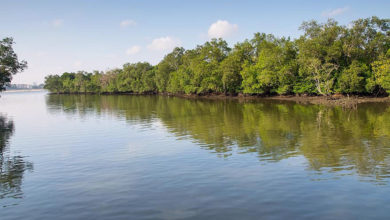
Material sleuth: Jane Mah Hutton and the hidden world of landscape supply chains
Have you ever wondered where the timber for the park bench you are sitting on came from? Or the fertiliser that helps your plants flourish? Jane Mah Hutton’s research into the stuff that our cities are made of is a call to action for more responsible material choices.
This article is part of our Living Cities special series, in advance of the 2022 Living Cities Forum on 21 July in Melbourne. It is made possible through the support of the Naomi Milgrom Foundation. You can buy tickets here
SueAnne Ware: What drives your curiosity around materials and their complex histories and exchanges?
Jane Mah Hutton: I started to make links between design ideas and material choices while working as a landscape architect. Every office has a materials library with samples of tiles, stone and fabrics, pointing to that exciting moment of moving beyond abstraction and into real textures, senses and materials. It was quite a shock to me when I realised that it is cheaper and is most cases preferred by the clients to specify stone from across the planet, rather than using Ontario limestone. Working as a landscape architect it was kind of unbelievable that something so heavy and so locally available wasn’t both more economical and more desirable.
In my early work I was designing landscapes without having the opportunity to connect to, or know about, the landscapes that these materials came from. I also noticed that when materials are marketed, the source of the materials are rarely shared. Maybe just a place name or processing category. Environmental labelling is crucial, but of course it only can tell so much. I became fascinated by all the stories that can’t be explained in a label.
While working at the Harvard Graduate School of Design I worked in the Loeb Library Materials Collection. This is an amazing collection that ranges from biomaterials and nanomaterials to shape-changing alloys and new “eco” materials. There is often so much emphasis on the ‘new’, but I became curious about what is not new. That is, most materials that make up the urban environment, whether that be soil, bricks, wood, steel and plants. I started to see the Loeb Collection as an index of the different ways that people transform landscapes to make materials to build things, whether forests or bedrock or oil deposits.
SAW: In your book, Reciprocal Landscapes: Stories of Material Movements, you wear a number of hats. You are a material sleuth tracing the origins of five everyday landscape materials. You are a landscape anthropologist of sorts, helping us to consider our built environments as deeply enchained with our cultural behaviours. Perhaps most importantly you raise a number environmentalist agendas in your exploration of global material flows. Can you extrapolate on one of the material journeys you take us on and discuss how this might help landscape architects make different material choices in the future?
JMH: Sure. One journey that comes to mind is that of ipe lumber (Handroanthus spp. formerly Tabebuia spp). This is a hard, durable tropical hardwood that comes from the Amazon. It has become a popular choice for large scale and well-funded public landscape architecture projects. In the last chapter of the book, I trace the movement of ipe from northern Brazil to the first phase of the High Line elevated park.
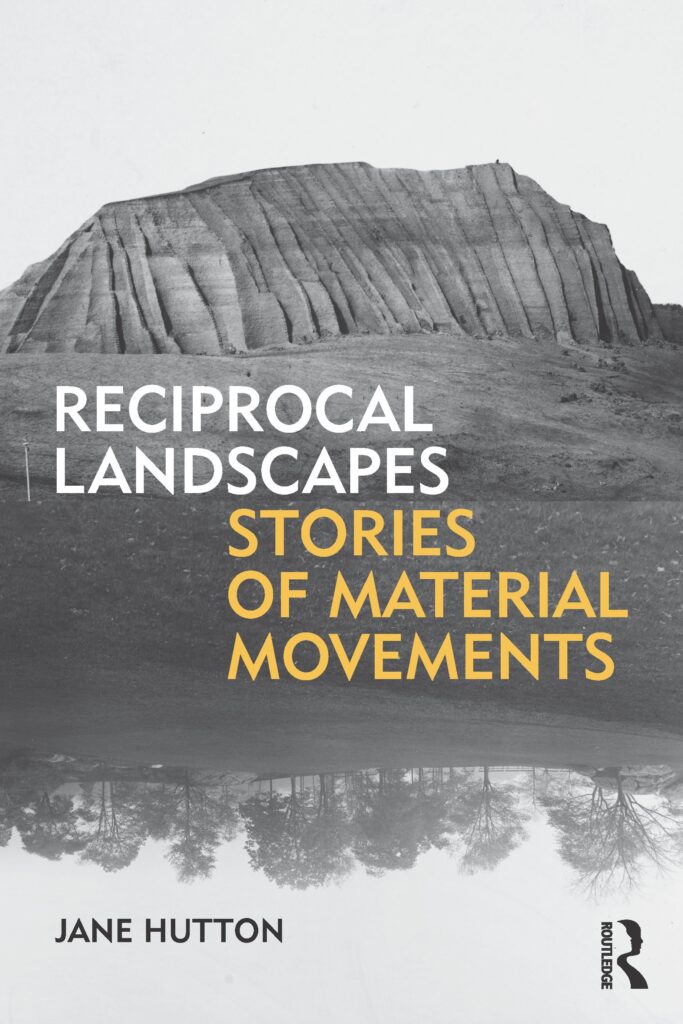
It was used as decking and furniture and for good reason. It is a beautiful wood that is so hard it must be pre-drilled to install, and it resists rot and insects naturally. It is very durable. This is obviously an important consideration as it means less frequent replacement or repairs. But at the same time, ecologists studying ipe have found that it is being overharvested and that sustainable harvesting is likely not possible at this time.
It is a slow-growing, sparsely distributed tree and its population has few juveniles and it is also very valuable. There is significant incentive for overharvesting and illegal harvesting, despite controls intended to manage this. Mahogany has similar growing characteristics and became seriously threatened through overharvesting. Ipe they say, is the new mahogany. Today we can see a lot of renewed interest in wood construction both for exterior and interior use. Ipe is specifically used outside, but in general this story reminds that wood is not just one thing. That the different contexts that different woods grow in have radically different consequences ecologically and socially.
While working on the book project Wood Urbanism with co-editors Daniel Ibanez and Kiel Moe, we spoke with Massachusetts-based forester Sean Mahoney. One of his major points, and something which I think applies to material specification in general, is that the point is not to seek ‘the perfect material’ and then just use it all the time. There are rarely silver bullets, and there is rarely a consequence-free material use in the contemporary industrialized materials market.
We must always think about how a forest is changing, and that it offers different species and types of wood at different times. We must see the selection and use of timber as a way of shaping the forest. This is a powerful metaphor for thinking about material use more broadly. It asks us to tune in to what’s there, what’s abundant, what is fair, and to share responsibility for the consequences of working with them.
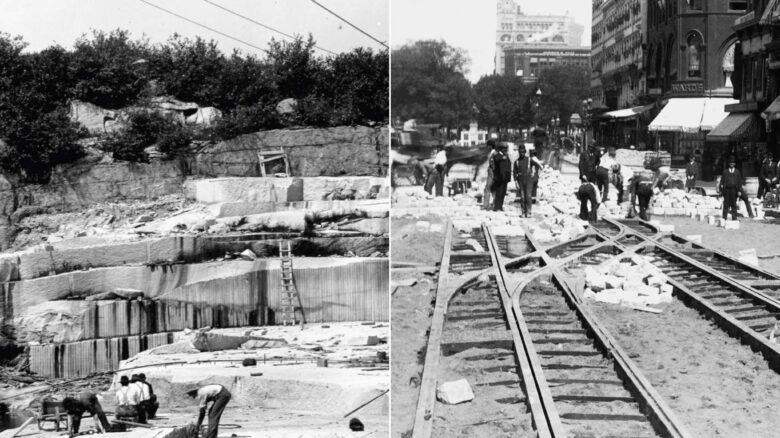
Page from Reciprocal Landscapes. Granite from Vinalhaven, Maine to Broadway, 1892
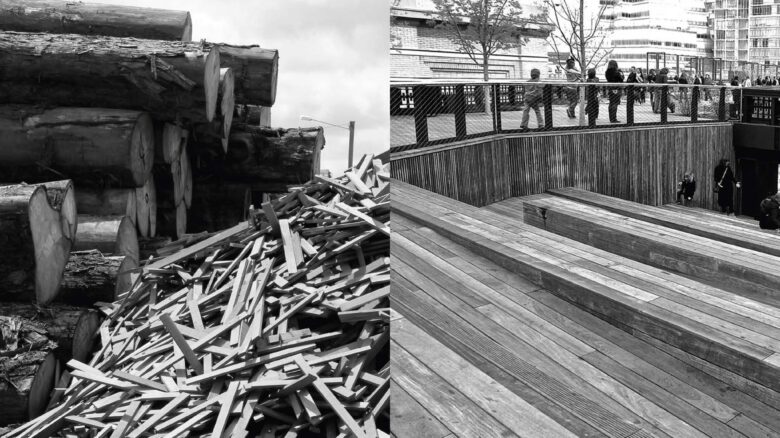
Page from Reciprocal Landscapes. Endangered ipe timber from Para, Brazil to the High Line, 2009.
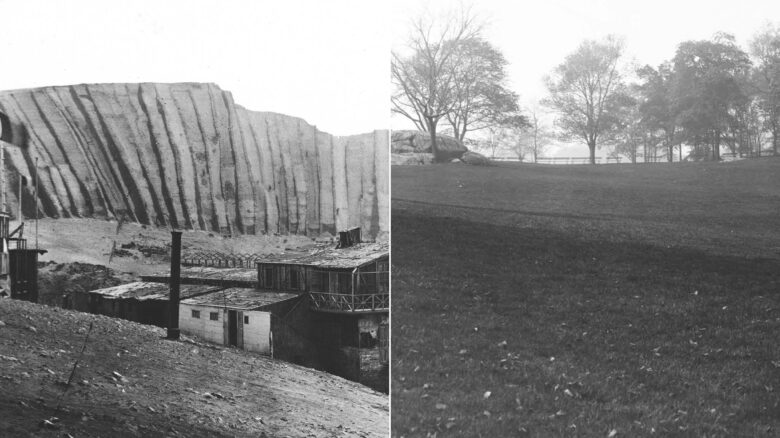
Page from Reciprocal Landscapes. Guano from Chincha Islands, Peru to Central Park, 1862
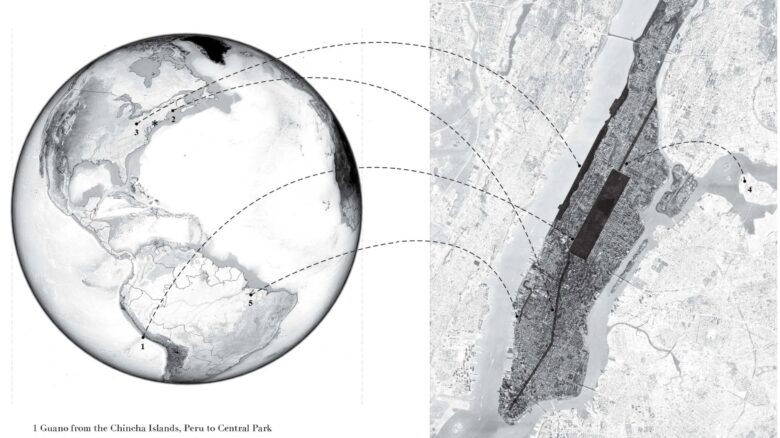
Page from Reciprocal Landscapes, tracking the source of the materials that made New York.
SAW: Were you influenced by Alan Berger’s research and work? I ask because his work in mapping the territories of mining and designing reclaimed post mining and industrial sites emphasizes the link between our consumption of natural resources, the waste and destruction of landscape, and global material flows. This is incredibly pertinent to Australia as we begin our clean energy transformation.
JMH: Alan Berger’s work was definitely part of my education in landscape architecture. Mentors and teachers of mine at the University of Toronto, like Pierre Belanger and Charles Waldheim, in different ways, were really emphasizing attention on the operational dimensions of landscapes and how neoliberal urban space is constructed and the role of landscape design within this.
In the past couple of decades there has been a lot of work done to try to understand and map these flows that extend so far beyond what has been part of landscape architecture’s agency. For me, this has always felt overwhelming. I didn’t know how to ground myself or my research in global dynamics that are so abstract and distant. So my research came about trying to connect what Is immediate and tangible (the material in front of me) to the distant and abstract (the global material flow).
There is so much to learn about fuel transitions. So much unknown, and at the same time, every sector needs to be thinking about adapting quickly. It is crucial that we pay attention to and participate in justice-focused transitions.
SAW: Switching tack slightly, Australian built environment professions are now exploring notions of Country and working towards the inclusion of Aboriginal and Torres Strait Islanders’ perspectives in our work. For example, there is historical and contemporary evidence of ‘trade routes’ and songlines from over 500 Aboriginal and Torres Strait Islander language groups in Australia, often where materials and cultural land practices flow. Are there parallels in Canada? What might this tell us about future ways of engaging and practicing landscape architecture?
JMH: This is something I would like to learn more about, but don’t feel I can speak to very well. I can say that my university is located in Southern Ontario in a tract of land called the Haldimand Tract that was promised to the Six Nations of the Grand River in 1784 by the British Crown. Instead it was rapidly sold off. In the past year Haudenosaunee Confederacy Chiefs Council called for a moratorium on development in the Tract, intending to exercise their jurisdiction of land and waters to halt resource exploitation, protect waterways and privilege land stewardship. While I don’t believe there has been much response to this moratorium, I think this has a direct message for anyone wanting to build in this land.
SAW: Are you hopeful that when the general public learns about material flows and exchanges, that landscape architects might be able to influence decision making towards more resilient and sustainable outcomes?
JMH: I think that awareness is always important. Realistically, designers have specific and important types of agency. They have the agency to support certain material flows by using them, and to create works that stimulate discussions and hearts. They can communicate with clients and the public, and advocate for policy change.
I think everyone is interested in knowing more about the social and ecological conditions of the materials they work with. Most people know that globalized material production tends to create devastating effects somewhere. But it is typically abstract and far away and hard to make these connections to oneself.
The food justice movement is an important model, because it has managed to build awareness of the impacts of industrial food production and has made strong links between land practices and the food people eat every day.
But I also think we have to be real about what any individual can do. I think this is a time for more radical mobilization, and for collective demands of the profession and policy makers to regulate at the scale commensurable with the climate emergency.
—
Jane Mah Hutton will be speaking at the Living Cities Forum on 21 July 2022 at Melbourne’s Federation Square. Book your tickets here. You can purchase her book Reciprocal Landscapes here.


